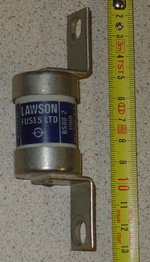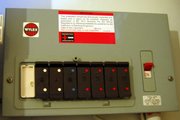Fuse (electrical)
|
|
In electronics and electrical engineering a fuse, short for 'fusible link', is a type of overcurrent protection device. It has as its critical component a metal wire or strip that will melt when heated by a prescribed (design) current, opening the circuit of which it is a part, thereby protecting the circuit from an overcurrent condition.
A practical fuse was one of the essential features of Edison's electrical power distribution system. An early fuse was said to have successfully protected an Edison installation from tampering by a rival from a gas-lighting concern.
| Contents |
Fuse time current characteristics
Each type of fuse has a time-current characteristic which shows the time required to melt the fuse for any given level of overload current. In power system design, main and branch circuit fuses can be co-ordinated for best protection by plotting the time-current characteristics on a consistent scale, making sure that the source fuse curve never crosses that of any of the branch circuits. To prevent damage to fuses, both "maximum clearing" and "minimum melting" curves are plotted.
Fuses are often characterized as "fast-blow" or "slow-blow," according to the time they take to respond to an overcurrent condition. Fast-blow fuses (sometimes marked 'F') open quickly when the rated current is reached. Ultrafast fuses (marked 'FF') are used to protect semiconductor devices that can tolerate only very short-lived overcurrents. Slow-blow fuses (often marked 'T') can tolerate a transient overcurrent condition, but will open if the overcurrent condition is sustained.
A fuse should normally be selected with a rating just over the normal operating current of the downstream wiring or equipment which it is to protect. Properly-selected fuses (or other overcurrent devices) are an essential part of a power distribution system to prevent fire or damage due to overload or short-circuits. Usually the maximum size of fuse for a circuit is regulated by law. For example, the Canadian Electrical Code, the United States National Electrical Code, and the UK Wiring Regulations provide limits for fuse sizes for a given conductor, and local authorities will incorporate these national codes as part of local law.
Fuse packages
Fuses are often sold in standardised packages to make them easily interchangeable. Cartridge fuses are cylindrical and are made in standard lengths such as 20 mm, 1 in (25.4 mm) and 1.25 in (31.75 mm). Smaller fuses often have a glass body with nothing but air inside so that the fuse wire can be inspected. Unfortunately under extremely high current faults such fuses can arc and therefore continue to supply a current. So fuses used in such situations (for example building wiring installations) have a stronger ceramic body and are filled with sand to quench any arcs (see maximum prospective short circuit current). Small fuses may be held by metal clips on their end ferrules, but larger fuses (100 amperes and larger) are often bolted into the fuse holder.
High-voltage fuses used outdoors may be of the expulsion type, allowing arc byproducts to be discharged to the air with considerable noise when they operate.
Blade fuses, with a plastic body and two prongs that fit into sockets, are used in automobiles.
Sub-miniature fuses for instruments may be rated as little as 50 milliamperes. These may have wire leads or may be fitted into small two-pin sockets. Sub-miniature fuses used in electronic devices may be directly soldered to a printed circuit board. Often these fuses are installed only to prevent a fire, and not to protect the electronic device.
Power circuit fuses
Fuses for power circuits are available in a wide range of ratings. Critical values in the specification of fuses are the normal rated current, the circuit voltage, and the maximum level of current available on a short-circuit. For example, in North America, a so-called "code" fuse may only be safely used in circuits with no more than 10,000 amperes available on a short circuit.
Fuses are used on power systems up to 115,000 volts AC. High-voltage fuses are used to protect instrument transformers used for electricity metering, or for small loads where the expense of a circuit breaker is not warranted. For example, in North American rural distribution systems, a 7200 volt power fuse may be used to protect a consumer's small power transformer.
Large power fuses have fusible elements made of silver or copper to provide stable and predictable performance.
Fuses compared with circuit breakers
Fuses have the advantages of often being less costly and simpler than a circuit breaker for similar ratings. High rupturing capacity fuses can be rated to safely interrupt up to 300,000 amperes at 600 V AC. Fuses can be selected that operate so quickly they limit the "let-through" energy into the circuit, helping to protect downstream equipment from damage. However, fuses are inherently a one-time-only device, requiring replacement after they've served their function. In a three-phase power circuit, if only one of the three fuses operates, the remaining phases will be unbalanced, with possible damage to motors. Fuses only sense overcurrent, or to a degree, overtemperature, and cannot usually be used with protective relaying to provide more advanced protective functions, for example, ground fault detection.
Fuse boxes
Old electrical consumer units (also called fuse boxes) were fitted with fuse wire that could be replaced from a supply of spare wire that was wound on a piece of cardboard. Modern consumer units contain magnetic circuit breakers instead of fuses. Cartridge fuses were also used in consumer units and sometimes still are as miniature circuit breakers (MCBs). Cartridge fuses are rather prone to nuisance tripping. (In North America, fuse wire was never used in this way, although so-called "renewable" fuses were made that allowed replacement of the fuse link. It was impossible to prevent putting a higher-rated fuse into a circuit ("overfusing") and so this form is now obsolete.)
The box pictured is a "Wylex standard". This type was very popular in the British Isles up until recently when the wiring regulations started demanding Residual-Current Devices (RCDs) for sockets that could feasibly supply equipment outside the equipotential zone. The design does not allow for fitment of RCDs or residual-current circuit breakers with overload (RCBOs) (an RCBO is the combination of an RCD and an MCB in a single unit). The one pictured is fitted with rewirable fuses but they can also be fitted with cartridge fuses and MCBs. There are two styles of fuse base that can be screwed into these units—one designed for the rewirable fusewire carriers and one designed for cartridge fuse carriers. Over the years MCBs have been made for both styles of base. With both styles of base higher rated carriers had wider pins so a carrier couldn't be changed for a higher rated one without also changing the base. Of course with rewirable carriers a user could just fit fatter fusewire or even a totally different type of wire object (hairpins, paper clips, nails etc.) to the existing carrier.
In North America, fuse boxes were also often used, especially in homes wired before about 1950. Fuses for these panels were screw-in "plug" type, in holders with the same threads as incandescent lamps, with ratings of 5, 10, 15, 20, 25, and 30 amperes. To prevent overfusing, later fuse boxes included restrictor features in the fuseholder socket. Some installations have resettable miniature thermal circuit breakers which screw into the fuse socket. One form of abuse of the fuse box was to put a penny (coin) in the socket, which defeated the overcurrent protection function and resulted in a dangerous condition. Plug fuses are no longer used in new residential or industrial construction, but are often found as branch circuit protection in electric cooking units (ranges).
British plug fuse
Fuses.jpg
The BS 1363 13 A plug has a BS 1362 cartridge fuse inside. This allows the use of 30 A/32 A (30 A was the original size; 32 A is the closest European harmonised size) socket circuits safely. In order to keep cable sizes manageable these are usually wired in ring mains. It also provides better protection for small appliances with thin flex as a variety of fuse ratings (1 A 2 A 3 A 5 A 7 A 10 A 13 A common ratings in bold) are available and a suitable fuse should be fitted to allow the normal operating current while protecting the appliance and its cord as well as possible. With some loads it is normal to use a slightly higher rated fuse than the normal operating current. For example on 500 W halogen floodlights it is normal to use a 5 A fuse even though a 3 A would carry the normal operating current. This is because halogen lights draw a significant surge of current at switch on as their cold resistance is far lower than their resistance at operating temperature.
In most other wiring practices the wires in a flexible cord are considered to be protected by the branch circuit overcurrent device, usually rated at around 15 amperes, so a plug-mounted fuse is not used. Small electronic apparatus often includes a fuseholder on or in the equipment, to protect internal components only.
Other types of fuse
So-called "self-resetting" fuses use a thermoplastic conductive element that opens the circuit on overload, then restores the circuit when they cool. These are useful in aerospace applications where replacement is difficult.
A "thermal fuse" is often found in consumer heating equipment such as coffee makers or hair dryers; it contains a fusible alloy which opens when the temperature is too high due to reduced air flow or other fault.
See also
- Earth leakage breakers are somewhat related.
- Semiconductor_fuses are very fast types of electrical fuses.
- Circuit breakers are an alternative to fuses for overcurrent and other protection
External links
- [1] (http://www.bussmann.com/apen/pubs/spd/index.asp) for the Bussman manual of fuse selection. Heavily oriented to United States NEC but has a good explanation of the principles of fuse selection.de:Elektrische Sicherung
es:Fusible fr:Fusible da:Elektrisk sikring it:Fusibile he:נתיך ja:電力ヒューズ nl:Smeltveiligheid pl:Bezpiecznik elektryczny


